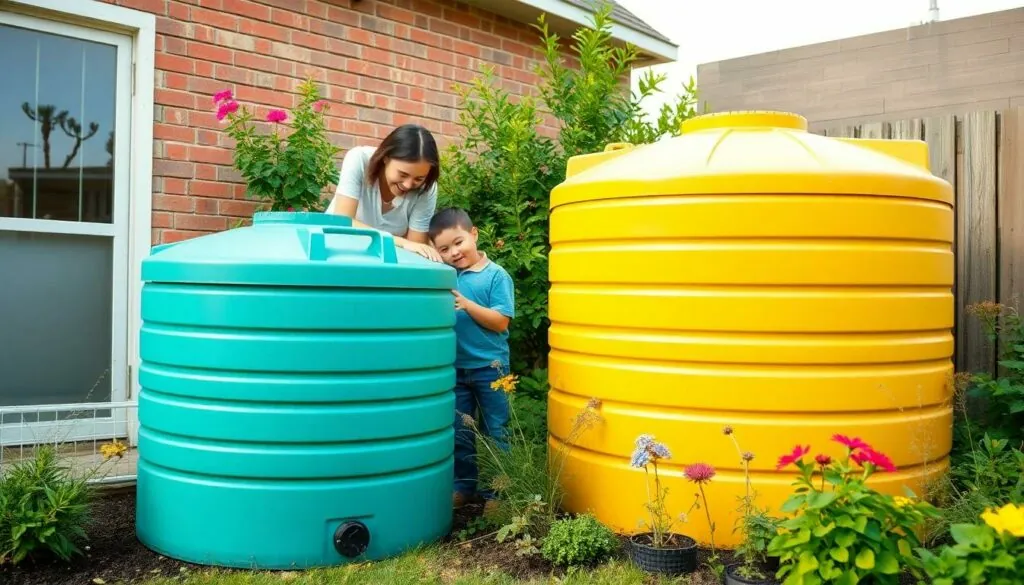Table of Contents
ToggleIn a world where water is more precious than gold, home water storage tanks are the unsung heroes of hydration. Imagine waking up to a hot summer day, only to find your taps running dry. Panic sets in, but not for those savvy enough to have a trusty tank stashed away. These tanks aren’t just big containers; they’re your personal reservoir of refreshment, ready to quench your thirst and keep your plants happy.
Overview of Home Water Storage Tanks
Home water storage tanks play a crucial role in managing water supplies for households. These tanks allow families to store water for various uses, such as cooking, drinking, and gardening. Available in multiple materials, including plastic, metal, and fiberglass, each type offers unique benefits.
Various sizes cater to specific needs, ranging from small 50-gallon tanks to large 10,000-gallon containers. Selecting the right size depends on factors such as family size and water usage rates. Placement options include basements, garages, or outdoors, with considerations for accessibility and protection from the elements.
Installation typically involves connection to existing plumbing or rainwater harvesting systems. Local regulations often govern installation methods, so consulting with professionals ensures compliance. Many tanks integrate filtration systems to maintain water quality and prevent contaminants.
Maintaining a home water storage tank includes regular inspections for leaks or damage. Doing so helps prevent water loss and preserves overall functionality. Additionally, periodic cleaning removes sediment buildup, ensuring that stored water remains safe for use.
Home water storage tanks serve more than just a practical purpose. They provide peace of mind during emergencies, enhancing self-sufficiency. By storing adequate resources, families can navigate droughts or natural disasters without the stress of water shortages.
Types of Home Water Storage Tanks
Home water storage tanks come in various types, each designed to meet specific needs. Understanding their differences helps select the right tank for a household’s requirements.
Above-Ground Tanks
Above-ground tanks are commonly used due to their cost-effectiveness and easy installation. Often made from plastic or metal, these tanks are simple to access for maintenance and inspections. They range in size from small 50-gallon units to larger containers holding over 10,000 gallons, accommodating diverse water storage needs. Placement usually occurs in yards or near homes, with considerations for sunlight exposure and accessibility. Additionally, the visible location can serve as a reminder for regular water quality checks.
Below-Ground Tanks
Below-ground tanks offer a discreet solution for water storage, making them ideal for homes with limited outdoor space. Constructed from durable materials such as fiberglass or concrete, these tanks provide excellent protection from environmental factors. Sizes vary significantly, catering to both small families and larger households. Installation requires professional assistance to ensure proper placement and drainage. These tanks often include advanced filtration systems, maintaining water purity while minimizing space usage and enhancing aesthetics in outdoor areas.
Portable Tanks
Portable tanks provide flexibility and convenience for various water storage needs. Often made from lightweight materials, they are easy to transport and can be used for gardening, camping, or emergency situations. Capacities generally range from 50 to 500 gallons, appealing to users seeking immediate access to water. Many portable options feature built-in pumps, enhancing usability for specific tasks. Proper care ensures longevity, making them a practical choice for temporary or seasonal usage.
Benefits of Home Water Storage Tanks
Home water storage tanks provide numerous advantages that enhance everyday living and preparedness. They offer solutions for water scarcity and promote efficient resource management.
Emergency Preparedness
Home water storage tanks serve as vital resources during emergencies. When natural disasters strike, these tanks supply immediate access to water, ensuring families remain hydrated. Storing significant volumes of water, they reduce reliance on municipal sources that may become disrupted. In scenarios involving droughts or severe weather, these tanks secure essential supplies, allowing households to navigate crises with confidence.
Cost-Effectiveness
Investing in home water storage tanks proves financially advantageous. Initial setup costs often recoup through savings on water bills over time. Families benefit from reduced utility expenses by using captured rainwater or stored water for gardening and other non-potable uses. Longevity of these systems typically leads to lower maintenance costs, contributing further to their overall value. Many tanks maintain quality over decades, establishing a reliable water source while minimizing the need for frequent replacements.
Installation Considerations
Installation of home water storage tanks involves crucial decisions that affect functionality and accessibility. These decisions often dictate the overall success of the system.
Choosing the Right Location
Selecting an appropriate location for a water tank is essential. The area needs to be accessible for maintenance and inspections. Proximity to downspouts or plumbing will facilitate connections. Ideally, the spot should avoid direct sunlight to minimize algae growth and heat exposure. Slope or elevation can assist gravity-fed systems, ensuring efficient water flow. Check local regulations on placement. Those guidelines may impact layout options and requirements.
Sizing Your Tank
Correct tank sizing directly impacts the system’s effectiveness. Consider the household’s daily water usage. For instance, a family of four typically consumes around 300 gallons per day. Selecting a tank size that accommodates this usage ensures enough supply during dry periods. Tanks range from 50 gallons for small needs to 10,000 gallons for larger households or specific agricultural purposes. Analyze the available space, both above and below ground. Available room will influence the type of tank chosen and its installation process.
Maintenance and Care
Home water storage tanks require routine upkeep to ensure optimal performance and water quality. Regular tasks include inspections and cleaning to prevent issues.
Regular Inspections
Inspecting tanks regularly helps identify leaks or damage early. Signs of wear might include cracks or corrosion on tank surfaces. Check fittings and valves for secure connections to prevent contamination. Keep an eye on water levels to monitor changes that may suggest leaks. Monthly inspections are ideal for spotting problems before they escalate. This proactive approach reduces maintenance costs and prolongs tank life, ensuring families always have access to clean water.
Cleaning Procedures
Cleaning water storage tanks maintains water purity and prevents sediment buildup. Schedule deep cleaning at least once a year, depending on water source quality. Begin by draining the tank completely. Use a mixture of bleach and water to scrub the interior surfaces. Rinse thoroughly to remove any remnants of cleaning solutions. After cleaning, inspect the tank for any signs of damage or corrosion. This routine keeps storage systems functional and safe, ensuring quality water for daily use.
Home water storage tanks are essential for ensuring a reliable water supply in today’s unpredictable climate. They not only provide peace of mind during emergencies but also promote self-sufficiency. By choosing the right type and size of tank, families can effectively manage their water needs while reducing reliance on municipal sources.
Regular maintenance and strategic placement further enhance the benefits of these systems. As water scarcity continues to be a pressing issue, investing in a home water storage tank is a proactive step towards sustainability and preparedness. Embracing this solution empowers households to navigate challenges related to water access with confidence.




